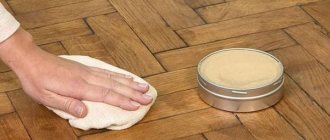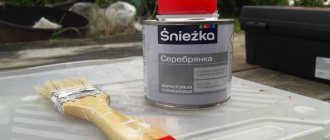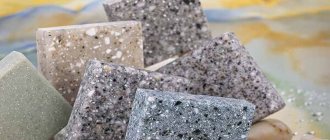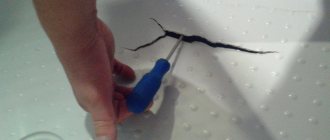Why do you need mastic?
When used correctly, these compounds help protect wood from swelling and deformation and create a reliable protective layer that:
- preserves natural color and makes it brighter;
- emphasizes the natural pattern of the fibers;
- reliably protects the wooden surface from dust and moisture.
Mastic saturates the wood with protective substances, making it resistant to moisture and giving it antiseptic properties. Wooden log houses treated with a special mastic can withstand wintering well, without fear of frost or snowfall. These compounds protect fibers, and regular treatment helps increase the service life of buildings for many years.
What are the benefits of waxing wood?
Treating wood with wax creates a thin protective film on the surface and, at the same time, penetrates deeply into the pores of the wood, enhancing its protection. Along with the above, the wax does not clog the pores and the wood continues to “breathe”.
Any type of wood can be treated with wax.
The only drawback of treating wood with wax is that it cannot be used in rooms with high temperatures. Because when heated, the wax begins to melt and flow out. This is where the disadvantages of waxing wood end.
Let's move on to the advantages of waxing, which are much more numerous than the disadvantages.
Wax impregnation increases the water-repellent properties of wood
Waxing wood improves the appearance, highlights the wood structure and adds shine. If you add coloring agents to the composition, you can adjust the shade of the wood.
Waxing protects the wood from cracking, damage by pests and fungi. Protects against scratches and other damage.
By the way: Wax-based impregnation can remove existing scratches on wood. You need to select a composition that matches the color and rub it on the area with the defect. The scratch will become almost invisible to the eye.
Composition and main characteristics
Wood mastic is prepared from a variety of components and comes in different varieties. But in general, mastics have one common property: excellent waterproofing. If they contain natural components, then the protective layer can stretch, exceeding the original area by more than 20 times, but without spreading or deforming.
Some compounds do not harden completely even many months after application. They have excellent adhesion: they fit well on a wooden surface and do not come off for a long time.
Mastic allows you to create a water-repellent layer, provides resistance to dust, ultraviolet radiation and various contaminants. The main advantage over conventional varnish is that it penetrates deep into the fibers and extends their service life, rather than remaining on the surface, like conventional compounds.
Treatment with mastic protects the log house from moisture, rotting and ultraviolet exposure
Beeswax for waxing wood
This wax has quite a few positive qualities:
- Absolute safety for the human body;
- Emphasizes the wood texture and gives it a matte golden hue;
- The wooden surface has water-repellent properties;
- Wax coating is able to “breathe” and does not interfere with the saturation of the air with the natural smell of wood.
Advantages and disadvantages
If you want to combine all the advantages of wood mastic and display them in a general list, it will look like this:
- Environmentally friendly. Here you need to take into account the composition of the substance.
- Durability. With regular care, wooden products can last for tens or even hundreds of years.
- Elasticity. It stretches well.
- Easy to apply. Mastic can be used by a person who does not have much experience in repair or construction.
- Protection against heavy loads. Wooden floors crack less and retain their structure.
- Improved aesthetics. Mastic gives the wood a pleasant shine, makes its color more rich and noble.
The disadvantage is that it is necessary to renew the coating 1-2 times a year. In addition, some formulations contain caustic chemicals, including gasoline and solvents, which evaporate and rise into the air when dry. This directly applies to cold-curing mastic. If you use one of these, you need to wear a protective mask, wait a few days and ventilate the room well before moving in.
Classification of mastic
It is worth taking a closer look at what kind of mastic can be found on sale and for what purposes it is intended. This useful information will help you make your choice.
Separation by technological features
Based on this factor, wood mastic is divided into 2 types:
- cold;
- hot.
The first contains gasoline, solvents and white spirit. If these fumes dry out, they can be harmful to health. The second is made from bitumen and rubber, and therefore is considered more environmentally friendly. It dries much faster.
Separation by composition
The product can be made not only from those components that were given above. For example, hard mastic for rubbing floors is made from beeswax, and it is effective and durable.
If you are treating floors that were previously laid with bitumen mastic (for waterproofing), then you cannot use products that contain turpentine. In such a case, it is better to consult a specialist.
There are also mastics:
- one-component - intended for one-time use, as they harden quickly;
- two-component - more suitable for reusable use, but first they must be mixed with a special thickener.
Selection of oil-wax
The key criterion is the composition of the product, what components are included in it. The final result and tone of the wood directly depend on this.
The product consists of:
- oil (linseed, olive or jojoba);
- beeswax;
- colors for color saturation;
- a solvent that makes the product not so thick (the lower its mass fraction, the faster the hardening occurs).
If you buy a ready-made product, make sure that the composition does not contain aggressive solvents or benzene. It is also necessary to take into account the type of wood, since both the absorption rate and the consumption of the product directly depend on this. Compositions for hardwood, softwood and exotic woods are available.
Oil-wax often contains additives that make the surface glossy and shiny. It looks impressive, and this product is suitable for interior work. But be careful, as the coating becomes slippery when treated with the composition.
Features of hot solutions
They have deep penetrating ability and durability. This mastic can protect wood even from damp soil and constant humidity, and therefore is used for treating basement floors, pillars and floor joists.
To apply such a mastic, it is necessary to heat it to a temperature of about 180 degrees Celsius. The process of using hot compounds is associated with health risks, since severe burns can occur.
Using a gas burner to impregnate wood with mastic
How to apply this material to the surface of wood
To apply mastic you can use:
- a brush with coarse bristles;
- an ordinary paint roller;
- spray gun.
Due to cost-effectiveness and availability, it is recommended to use a roller and brushes. They don't require much practice and are cheap, so you can always buy new tools at any hardware or hardware store.
Making your own mastic
If you don’t want to use ready-made mastic for one reason or another, you can make it yourself. To do this you will need the following components:
- wax (carnauba or beeswax) - 4 parts by mass;
- rosin (pine or gum) - 1 wt. share;
- turpentine (gum) - 2 wt. shares.
Strictly follow the indicated proportions. First you need to grate the wax and mix it with crushed rosin. Then this mixture is melted in a water bath (you need to stir it systematically).
Next comes the most dangerous part. Turpentine is very flammable. It must be heated in a container with hot water and avoid exposure to open flames. Heated turpentine is added to the prepared mixture of wax and rosin and mixed thoroughly.
At the last stage, the resulting mass is poured into a container. It cools and thickens, after which it can be used for application to wooden surfaces. Using mastic, you don’t have to worry about the condition of the wood: the coatings will be protected from abrasions, dirt and the appearance of unwanted microorganisms.
Cooking methods
It's time to talk about how to prepare oil-wax at home and what components are required for this. For greater convenience, we will give the mass fraction of the ratio of ingredients. Follow this recommendation and you will be able to prepare a high-quality product for treating wood floors.
Wax, turpentine and rosin
This composition is ideal for furniture because it allows you to create a special protective film, thanks to which dust does not harm the surface of the wood in any way, and a characteristic coating does not form on top.
This became possible thanks to the addition of turpentine. It makes the composition not so thick, which simplifies application and allows you to work with the surface as much as necessary.
It is necessary to melt the wax to a liquid state, add crushed rosin. Mix the ingredients and wait until they are completely dissolved, then pour in the turpentine and stir.
Paraffin, gasoline, rosin
This composition is suitable for outdoor use. If you have a wooden terrace, gazebo, bench and canopy, then it will protect them from the harmful effects of external factors. The product contains gasoline and is used in places where there are no increased environmental requirements.
Gasoline can be replaced with purified acetone. It costs more, but disappears faster, leaving no odor. When preparing the product, follow safety precautions, especially when melting paraffin. It is necessary to keep the container with gasoline away from fire.
It is better to prepare the product outdoors, which will help avoid concentration of vapors. If this is not possible and you are forced to mix the ingredients at home, then take care to ventilate the room.











